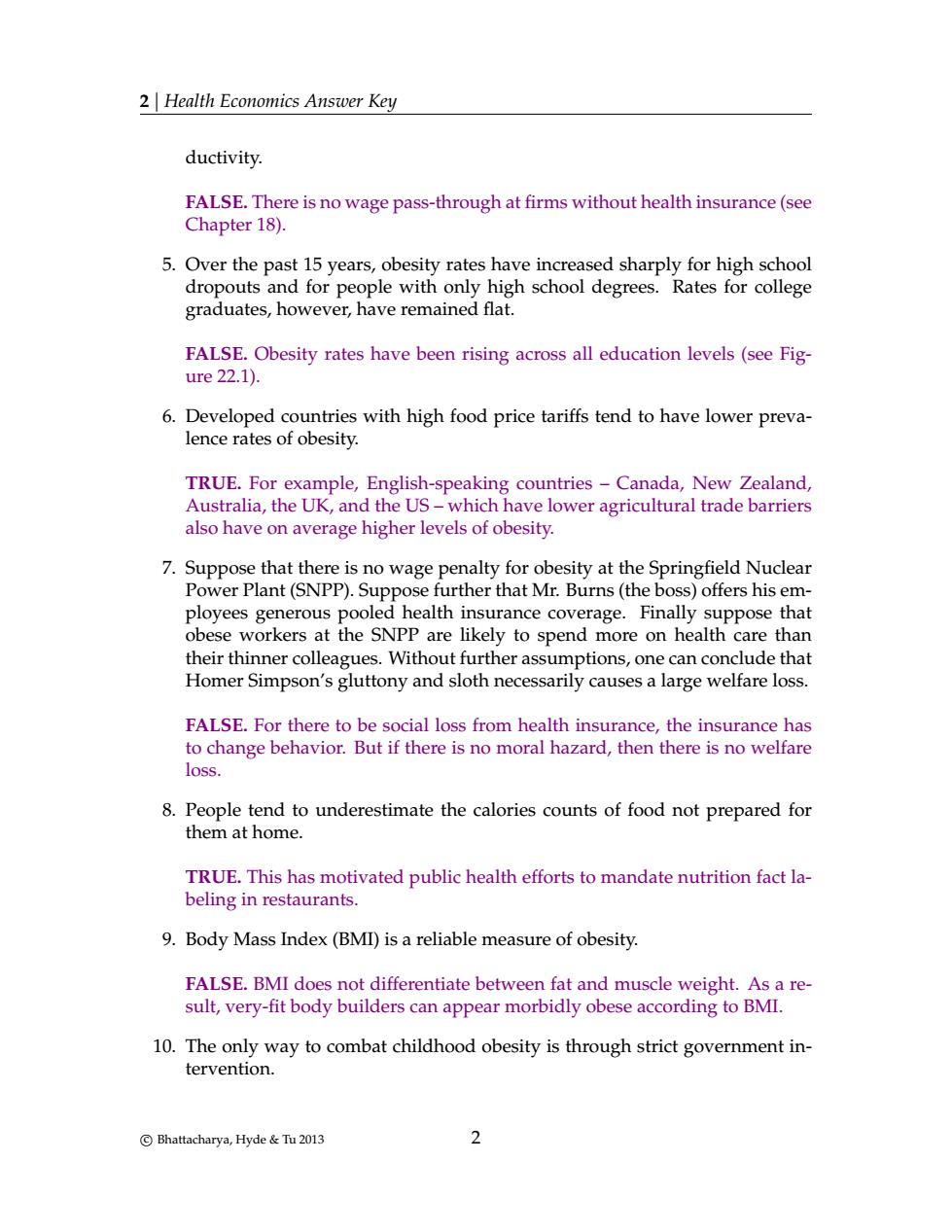正在加载图片...

2 Health Economics Answer Key ductivity. FALSE.There is no wage pass-through at firms without health insurance(see Chapter 18). 5.Over the past 15 years,obesity rates have increased sharply for high school Rates for college ave remained flat FALSE.Obesity rates have been rising across all education levels(see Fig- ure22.1). 6.Developed countries with high food price tariffs tend to have lower preva- lence rates of obesity. TRUE.For example,English-speaking countries-Canada,New Zealand Australia,the UK,and the US-which have lower agricultural trade barriers also have on average higher levels of obesity. Suppose that ther is no wage penalty for obesity at the Springfield Nuclear r Plant(SNPP)Sup ose further that Mr.Bu rns(the boss)offers his em- health urance coverag Finall uppose tha their thinner colleagues.Without further assumptions,one can conclude that Homer Simpson's gluttony and sloth necessarily causes a large welfare loss. FAlsE.for there to be social loss from health insurance.the insurance has to change behavior.But if there is no moral hazard,then there is no welfare loss 8.People tend to underestimate the calories counts of food not prepared for them at home TRUE.This has motivated public health efforts to mandate nutrition fact la- beling in restaurants. 9.Body Mass Index(BMI)is a reliable measure of obesity. FALSE.BMI does not differentiate between fat and muscle weight.As a re- sult,very-fit body builders can appear morbidly obese according to BMI. 10.The only way to combat childhood obesity is through strict government in- tervention. Bhattacharya,Hyde &Tu2013 2 2 | Health Economics Answer Key ductivity. FALSE. There is no wage pass-through at firms without health insurance (see Chapter 18). 5. Over the past 15 years, obesity rates have increased sharply for high school dropouts and for people with only high school degrees. Rates for college graduates, however, have remained flat. FALSE. Obesity rates have been rising across all education levels (see Figure 22.1). 6. Developed countries with high food price tariffs tend to have lower prevalence rates of obesity. TRUE. For example, English-speaking countries – Canada, New Zealand, Australia, the UK, and the US – which have lower agricultural trade barriers also have on average higher levels of obesity. 7. Suppose that there is no wage penalty for obesity at the Springfield Nuclear Power Plant (SNPP). Suppose further that Mr. Burns (the boss) offers his employees generous pooled health insurance coverage. Finally suppose that obese workers at the SNPP are likely to spend more on health care than their thinner colleagues. Without further assumptions, one can conclude that Homer Simpson’s gluttony and sloth necessarily causes a large welfare loss. FALSE. For there to be social loss from health insurance, the insurance has to change behavior. But if there is no moral hazard, then there is no welfare loss. 8. People tend to underestimate the calories counts of food not prepared for them at home. TRUE. This has motivated public health efforts to mandate nutrition fact labeling in restaurants. 9. Body Mass Index (BMI) is a reliable measure of obesity. FALSE. BMI does not differentiate between fat and muscle weight. As a result, very-fit body builders can appear morbidly obese according to BMI. 10. The only way to combat childhood obesity is through strict government intervention. c Bhattacharya, Hyde & Tu 2013 2